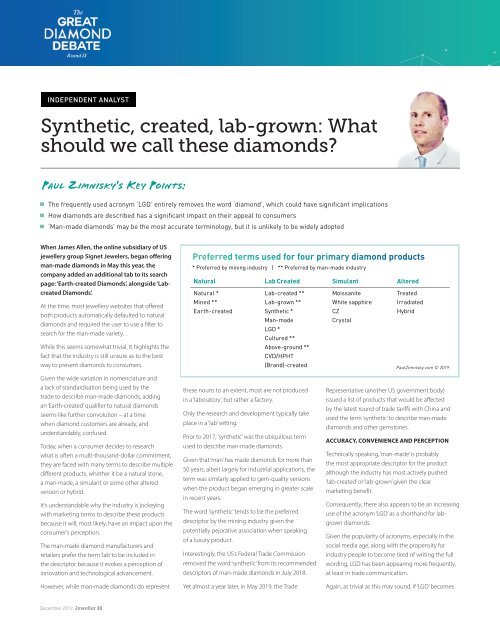Jeweller: The Great Diamond Debate - Round II
Facts Vs Marketing: In 2019, both natural and man-made diamonds battled for the hearts and minds of consumers – and the gloves came off. While the dust is far from settled, the question remains: can consumers really make an informed choice in the midst of a marketing barrage and an increasingly confused industry?
Facts Vs Marketing: In 2019, both natural and man-made diamonds battled for the hearts and minds of consumers – and the gloves came off. While the dust is far from settled, the question remains: can consumers really make an informed choice in the midst of a marketing barrage and an increasingly confused industry?
Create successful ePaper yourself
Turn your PDF publications into a flip-book with our unique Google optimized e-Paper software.
INDEPENDENT ANALYST<br />
Synthetic, created, lab-grown: What<br />
should we call these diamonds?<br />
PAUL Z IMNISKY‘S KEY POINTS:<br />
<strong>The</strong> frequently used acronym ‘LGD’ entirely removes the word ‘diamond’, which could have significant implications<br />
How diamonds are described has a significant impact on their appeal to consumers<br />
‘Man-made diamonds’ may be the most accurate terminology, but it is unlikely to be widely adopted<br />
When James Allen, the online subsidiary of US<br />
jewellery group Signet Jewelers, began offering<br />
man-made diamonds in May this year, the<br />
company added an additional tab to its search<br />
page: ‘Earth-created <strong>Diamond</strong>s’, alongside ‘Labcreated<br />
<strong>Diamond</strong>s’.<br />
At the time, most jewellery websites that offered<br />
both products automatically defaulted to natural<br />
diamonds and required the user to use a filter to<br />
search for the man-made variety.<br />
While this seems somewhat trivial, it highlights the<br />
fact that the industry is still unsure as to the best<br />
way to present diamonds to consumers.<br />
Preferred terms used for four primary diamond products<br />
* Preferred by mining industry | ** Preferred by man-made industry<br />
Natural Lab Created Simulant Altered<br />
Natural *<br />
Mined **<br />
Earth-created<br />
Lab-created **<br />
Lab-grown **<br />
Synthetic *<br />
Man-made<br />
LGD *<br />
Cultured **<br />
Above-ground **<br />
CVD/HPHT<br />
(Brand)-created<br />
Moissanite<br />
White sapphire<br />
CZ<br />
Crystal<br />
Treated<br />
Irradiated<br />
Hybrid<br />
PaulZimnisky.com © 2019<br />
Given the wide variation in nomenclature and<br />
a lack of standardisation being used by the<br />
trade to describe man-made diamonds, adding<br />
an ‘Earth-created’ qualifier to natural diamonds<br />
seems like further convolution – at a time<br />
when diamond customers are already, and<br />
understandably, confused.<br />
Today, when a consumer decides to research<br />
what is often a multi-thousand-dollar commitment,<br />
they are faced with many terms to describe multiple<br />
different products, whether it be a natural stone,<br />
a man-made, a simulant or some other altered<br />
version or hybrid.<br />
It’s understandable why the industry is jockeying<br />
with marketing terms to describe these products<br />
because it will, most likely, have an impact upon the<br />
consumer’s perception.<br />
<strong>The</strong> man-made diamond manufacturers and<br />
retailers prefer the term ‘lab’ to be included in<br />
the descriptor because it evokes a perception of<br />
innovation and technological advancement.<br />
However, while man-made diamonds do represent<br />
these nouns to an extent, most are not produced<br />
in a ‘laboratory’, but rather a factory.<br />
Only the research and development typically take<br />
place in a ‘lab’ setting.<br />
Prior to 2017, ’synthetic’ was the ubiquitous term<br />
used to describe man-made diamonds.<br />
Given that ‘man’ has made diamonds for more than<br />
50 years, albeit largely for industrial applications, the<br />
term was similarly applied to gem-quality versions<br />
when the product began emerging in greater scale<br />
in recent years.<br />
<strong>The</strong> word ’synthetic’ tends to be the preferred<br />
descriptor by the mining industry given the<br />
potentially pejorative association when speaking<br />
of a luxury product.<br />
Interestingly, the US’s Federal Trade Commission<br />
removed the word ‘synthetic’ from its recommended<br />
descriptors of man-made diamonds in July 2018.<br />
Yet almost a year later, in May 2019, the Trade<br />
Representative (another US government body)<br />
issued a list of products that would be affected<br />
by the latest round of trade tariffs with China and<br />
used the term ‘synthetic’ to describe man-made<br />
diamonds and other gemstones.<br />
ACCURACY, CONVENIENCE AND PERCEPTION<br />
Technically speaking, ‘man-made’ is probably<br />
the most appropriate descriptor for the product<br />
although the industry has most actively pushed<br />
‘lab-created’ or ‘lab-grown’ given the clear<br />
marketing benefit.<br />
Consequently, there also appears to be an increasing<br />
use of the acronym ‘LGD’ as a shorthand for labgrown<br />
diamonds.<br />
Given the popularity of acronyms, especially in the<br />
social media age, along with the propensity for<br />
industry people to become tired of writing the full<br />
wording, LGD has been appearing more frequently,<br />
at least in trade communication.<br />
Again, as trivial as this may sound, if ‘LGD’ becomes<br />
December 2019 <strong>Jeweller</strong> 30


















